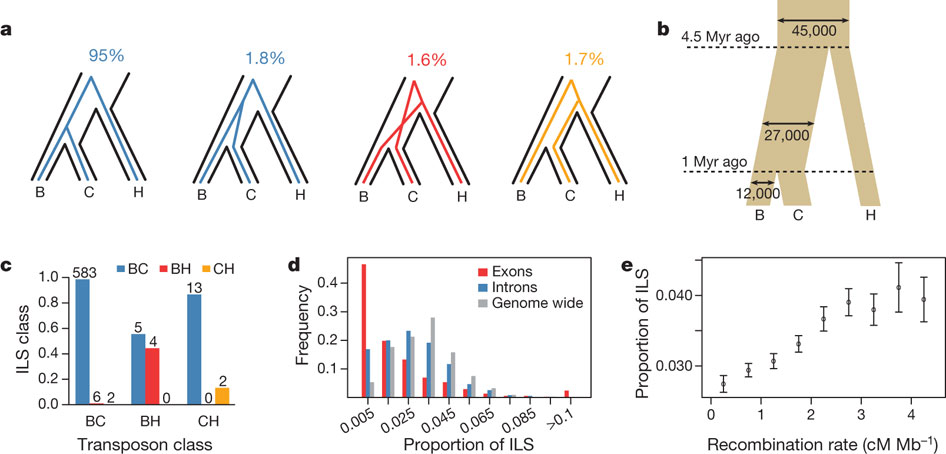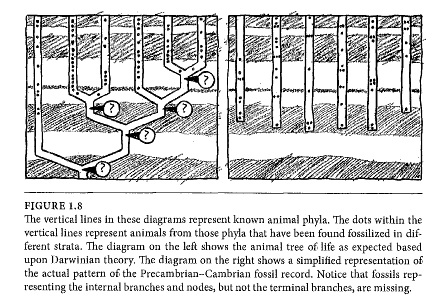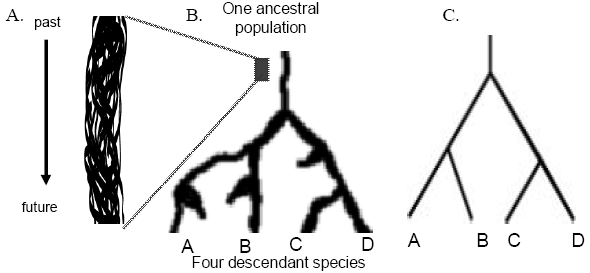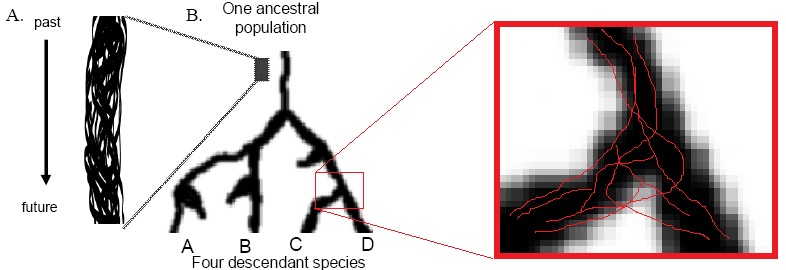We continue the last section that we began (location 567 Kindle edition* and pg 20 print), An Old Fossil Recovered.
I wanted to spend some time on this because it shows a very common mistake made by many people, not just creationists. Creationists, however, capitalize on this misconception for their own ends… even when they know better. There’s two possibilities here. Either Meyer really doesn’t know any better, in which case, he should never have written this book in the first place. Or, he does know better and is still saying it incorrectly, in which case… well…
This misconception has to do with what is expected from the fossil record.
Rather, the problem, according to Agassiz, was the selective incompleteness of the fossil record.
Why, he asked, does the fossil record always happen to be incomplete at the nodes connecting major branches of Darwin’s tree of life, but rarely—in the parlance of modern paleontology—at the “terminal branches” representing the major already known groups of organisms? These terminal branches were well represented (see Fig. 1.8), often stretching over many generations and millions of years, while the “internal branches” at the connecting nodes on Darwin’s tree of life were nearly always—and selectively—absent. As Agassiz explained, Darwin’s theory “rests partly upon the assumption that, in the succession of ages, just those transition types have dropped out from the geological record which would have proved the Darwinian conclusions had these types been preserved.”53 To Agassiz, it sounded like a just-so story, one that explains away the absence of evidence rather than genuinely explaining the evidence we have.
And it accompanied by this graphic
You’ll notice that the left half is a common graphical representation of evolution. There are two common ways of showing evolutionary relationships, cladograms and phylogenetic trees. This isn’t a cladogram because nodes aren’t organisms in a cladogram. So this must be a phylogenetic tree.
So, why is this a problem for me in this case? It’s actually very simple.
Unlike what many people think, evolution doesn’t occur at an individual level. It occurs at the population level. Remember a while back we talked about how there is often much more variation within populations than between parent/offspring? This is why we don’t expect to find that single individual that is the exact last common ancestor between two groups.
An illustration is in order here. This is from Scitable by Nature Education. I was thinking about doing this by hand, but this one is so much better. I’ve made some minor modifications to emphasize what we’re talking about.
This the phylogenetic tree that we all think of. Species A and B are closely related. Species C and D are closely related and all four share a common ancestor. Now the problem as stated by Agassiz (via Meyer) is that we don’t have examples of the fossils at the nodes (I’ve circled the nodes in red).
But those nice clean lines are really meaningless. Species aren’t a single organism and evolution doesn’t happen to individuals. Evolution occurs in populations. So in reality, the tree looks more like this.
Those nice clean lines are really aggregates of millions, possibly billions of individuals over a period of millions of years (generally). Look at part A. Each line represents an individual. Two individuals briefly come together and a whole bunch of new lines form, the offspring.
Let’s look at a blow up of one of those nodes.
I’ve added some of the tracks of populations. Notice how some groups follow one branch early on. Some begin to follow one track, but move over to another track. Some then move back.
Now, the question for Meyer and Agassiz is, which one of those population tracks contains the individual that is the dividing point between species C and species D?
Or let me ask this in another way.
Which of the above breeds of dogs is the nodal individual for the varying species of dog that will appear in 3 million years (give or take).
Yes, that is a valid question. Because it’s why Meyer and Aggasiz’s point here is wrong. All of those dogs are the same species… now. But after 3 million years of evolution (whether it be human induced or not), do you really think that corgis, pugs, and spaniels will be the same species as the sheepdogs and deerhounds. Yes, over the next 3 million years, there will be some mutts that are cross breeds between pugs and beagles and between sheepdogs and collies. But there will be less and less between the small and toy dogs and the large and giant dogs. It will take time, more time than humans have been alive, but these will become separate species. It’s already happened with the foxes.
Now, before you say “That’s a just-so story”, it’s not. One group of organisms have had several species genomes completely analyzed and this pattern appeared. There was some cross-breeding, so much that it’s visible at the genomic level, for several million years. I refer to this image that details this, also from Nature.

Of course, the species I’m referring to here are the human, chimpanzee, and bonobo.
Now, looking at the data above (I’m sure the authors would be willing to share the original data if you have a good experimental plan), which individual in that 3.5 million year period, is the one that is the nodal species?
One last point. The fossil record of these types of splits is very limited. In general, they occupy a brief period of time, geologically speaking. One spring, many, many moons ago, I spent some time doing field work in south Texas. We were looking at a marine/estuary fossil bed that was between 48 million and 42 million years old. It was compressed into a fossil layer about 6 inches thick. Nearly six million years of living things compressed into 6 inches of rock.
Only specific regions have good chances of fossilization happening. Rain forests, mountains, and similar environments offer very, very poor chances of fossilization. Any place that there are significant scavenger species, ranging from vultures and lions to beetles and ants, are poor areas for fossilization.
Further, as Gould and Eldridge pointed at, species tend to remain stable over long periods of time, then rapidly diversify due to various pressures. This is called punctuated equilibria and is a well known process to modern scientists.
Finally, as we’ve pointed out before and like the dogs show, being able to decide whether an organism is a particular species or another is not a trivial task. Careers and reputations have been made and ruined by claims of this sort. We don’t know which dogs will become separate species in the future. We can’t tell which snail became a new species, because at the time, they are all the same. It gets much worse when all you have to look at is a few bones or a shell of an animal.
All of these factors contribute to what Agassiz calls the lack of fossils at the internal branches. But… and this is a big but… there are a few.
Tiktaalik. Which further proves the point that there is no fixed time when species diverged. But more on that later.
Please ask questions, I hope I was clear, but I don’t want any misunderstandings.
____________________________________
* Please note that I’m doing this on a Kindle. I like e-books. I encourage their use.






